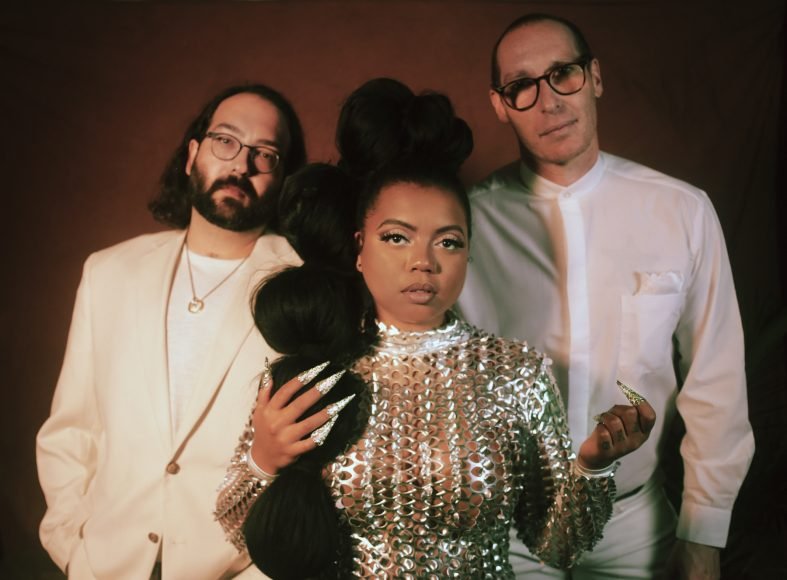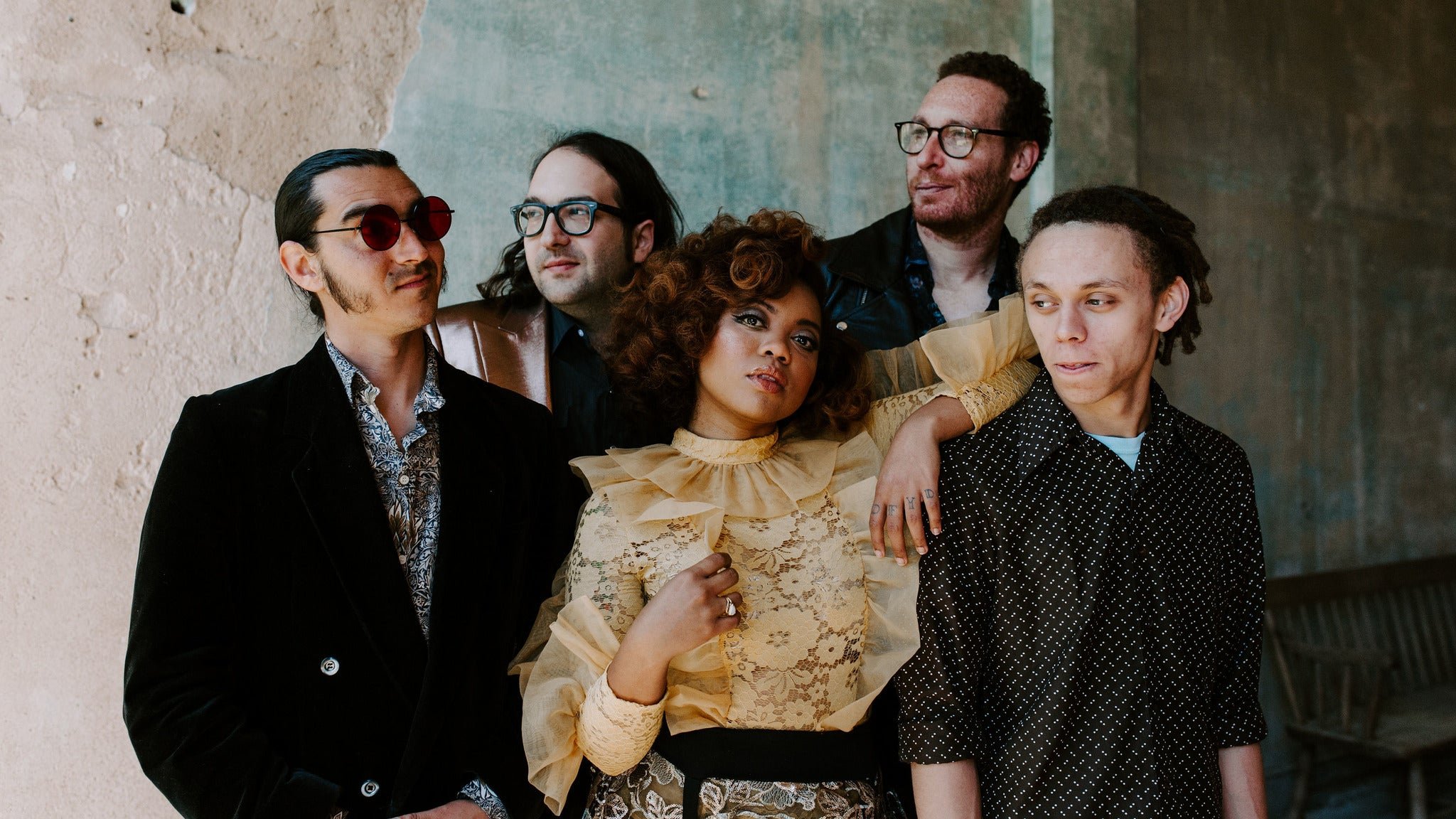AJ Haynes of Seratones Wants You to be Free

Seratones by Joshua Asante
The front woman of the soul rock group and reproductive rights activist has created a record to liberate our bodies
AJ Haynes breaks through the television static to give us a cosmic message. The front woman for Shreveport’s Seratones stands in all white for the “Good Day” video, purple light illuminating her skin and eyes filled with fluorescent indigo. “Do you really want to get better? Do you really want to get well?” she sings, voice quivering. It’s an invitation to us all.
Steel drum synths clang and bang to life in the background of the music while dance beats pulsate. You get the feeling that the world isn’t as rigid as it has always been made out to be. Maybe it’s a little bit easier than we think to push through and get to the other side. Maybe liberation is something we can taste in the sweat of the dance floor, shoulders pressed close, bodies set free. The story of Seratones is the story of how a woman scorched the earth, and how through the tough dirt, wild flowers grew. It’s a story of change, and it’s a story of a band who’s not afraid to do it.
I don’t want to mythologize AJ Haynes. She is an indie artist with three albums, and she’d probably hate me for making her seem like she emerged fully formed from the brow of Zeus. But she’s an extremely impressive person, and painting her as a minor deity makes sense after talking to her. Haynes would probably say that it’s a comparison that isn’t helpful, but the mission of her art is for us as listeners to see all sides of her humanity and, in the process, theirs. She wants to show us that everyday people are holy and deserving of their own origin myths.
Love and Algorythms, the band’s third album, is an epic of queer love and existence. They’re on tour now in support of it. It’s idea-driven, with references to such intellects as Octavia Butler and Audre Lorde running through it to such a degree that Haynes will host regular “Interconnection Sessions” on Zoom to meditate and talk with fans about the texts and ideas that influenced the songs. But it’s also an album that focuses on the out-of-body through music made for the dance floor. There are synth solos reminiscent of early electronica and moments where house beats climb towards infinity. There’s weight with the words that Haynes sings, and intentionality behind every one of them. Yet, it’s the music, the sound of Haynes’ voice, that drives us to nirvana. Haynes wants us to feel freedom, not just understand the idea of it.
Haynes is the kind of person who absorbs everything within her reach. Talking to her is like talking to someone who is able to carry mental index cards in the most charming and unpretentious way possible. She’ll cite sources and quote authors off the top of her head. Her speaking voice is soft and filled with wonder, yet firm and unshakeable. She’s quick to respond, yet thoughtful, never speaking too fast for anyone to miss a word.
The idea of getting free has been a rock spinning around in Haynes’ head throughout every Seratones album. In the early iterations, Haynes was pushing her voice against a wall of sound to try and carve a space for herself to exist. She was fighting to lead the band. As a queer, Black woman who’s also short in stature, she was quite literally being talked down to.
“I would have an idea and it would get shut down because someone didn’t see the vision or didn’t see the value in it,” Haynes reflects. She was not only fighting to be heard on the tracks themselves—listen to “Headtrip” off of 2016’s debut Get Gone, and how Haynes duels the lead guitar for the song's melody—but she was also fighting to be seen as someone who had just as much to give as anyone else in the room.
Haynes wanted to get free, so she did. After Seratones’ debut record, Haynes forced the lead guitarist out of the band, steering the sound away from guitar rock and into something more retro and contemporary at the same time. The band put down the stuck-in-the-Sixties MC5 garage punk in favor of something that gave you Marvin Gaye’s What’s Going On? deja vu, but without a vintage gear obsession. Out of her fixation with ‘60s girl groups and ‘70s soul came Power, an album that solidified Haynes as the creative nucleus of Seratones.
Haynes didn’t have a concept for Power like Love and Algorythms, but the process of creating the record was similar. She did the reading, the research, and went from there. In a Da Vincian way, she understands her art as both mechanism and expression. Power was the story of burning everything down, then creating music out of the ashes and smoke. Haynes versus the demons within and around her. But with Love and Algorythms, Haynes had to face the issue of self-preservation. How do you stay in this for the long run?
“In order to make this album, I had to choose myself,” says Haynes, collecting her thoughts out of moments of silence. Love and Algorythms required a level of sacrifice. While she wrote the record, COVID hit and the band's tour for Power was cut short in San Francisco. Her bandmates went home, and Haynes had one day to do laundry before starting as a patient advocate for Hope Medical Group, which at the time, was one of three open abortion clinics in all of Louisiana.
You might recognize Hope Medical Group’s name from the news recently. The Shreveport-based clinic has challenged Louisiana's abortion ban that immediately went into effect with the constitutional overturn of Roe v. Wade two weeks ago. The lawsuit has resulted in a temporary restraining order, allowing abortions to continue at the clinic, a major feat for an abortion provider nestled in the deep Bible Belt of the U.S.
The clinic has stayed open and continued to see patients despite the efforts of Louisiana Attorney General Jeff Landry and Governor John Bel Edwards to shut them down for years. “We continued to adjust and to adapt, and you know, that requires a lot of a person,” says Haynes, reflecting on her time there. Working at an abortion clinic in Louisiana during COVID meant working within a crisis within a crisis. She was exhausted, and approaching burn out.
“That’s when I was like, I can’t burn out. I have a whole music career,' Haynes says through laughter. Even though the team at Hope Medical felt like family to her, she knew that to continue would be death. Her mind and spirit was sinking. “I had to leave the clinic to save myself.``
Haynes left Hope medical, but she couldn’t fully leave the fight for reproductive rights. She took a position with the New Orleans Abortion Fund, which gave her the time and space to create the record she knew she needed to make. As Haynes began creative regeneration and writing for the new record, she realized that pleasure is necessary for survival. Rest and relaxation is radical. Resilience is rooted in joy.
Afro-futurist landscapes unfolded before her eyes. Like Octavia Butler, she wanted to take root amongst the stars. She didn’t want the highest highs or lowest lows that came with Power. Instead, she wanted balance. Serenity that rushes in like running water. An equilibrium strong enough to match Earth’s gravity, and break through it.
Haynes embraced a new sound to help her reach this liberation. She found solace in disco, a genre that historically has provided safety for marginalized communities. Dance music has always been a way to escape to worlds where you belong, to planets far enough away from what wants to destroy you. “Sunset to sunrise / Wish I could see the world through both of your eyes,” Haynes sings in “Two of A Kind.” Arpeggiated synths cycle and burn, whirring like a VHS home video as Haynes sings of queer love.
“Two of a Kind '' has a euphoric energy to it that might have been foreign to old Seratones records. The synth solo and breakdown is reminiscent of Kraftwerk’s play with early synths and the first electronic music. It’s one of those songs that you could roller skate to for infinity, like Donna Summer’s “I Feel Love.” Haynes wanted freedom to be felt in our bodies, to interpret this whole new mess of a world with music that has always pushed us to dance, let go, and be resilient.
In the music video for “Good Day,” average people are set free to be one with space, the great stars above. Their beds are abducted by aliens, and they are taken along with them, placed in fields of golden grass. The people run under the blue sky, white sheets towed behind like superhero capes, soft cotton kites that brush through the air. As a Wurlitzer rings out, and Haynes sings like she’s in church, everyone begins to levitate. These bodies are ours. They are meant to be liberated.






